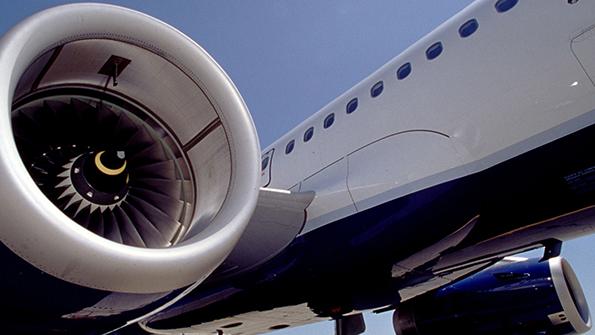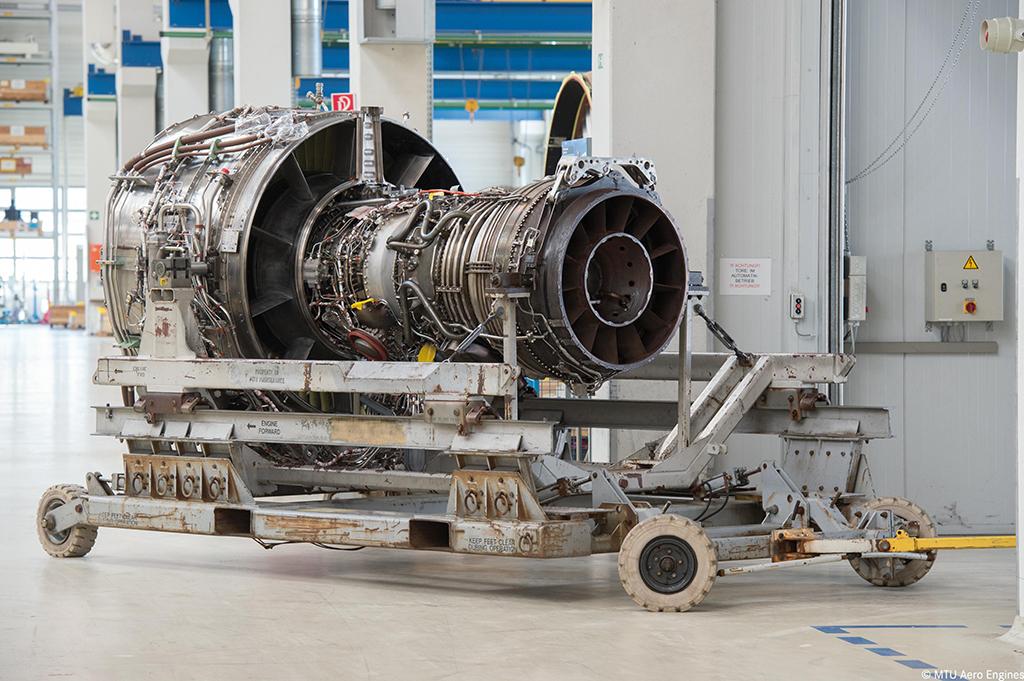
Although the average age of the International Aero Engines V2500 engine fleet is about 11 years, some of the powerplants are approaching midlife. Aviation Week’s Fleet & MRO database shows there are about 5,500 V2500-A5 engines in service, with 54 expected to retire this year. Of those, 2,989 power the Airbus A320 and 1,898 power the A321.
In 1984, IAE, a multinational consortium of Pratt & Whitney, Pratt & Whitney Aero Engines International, Japanese Aero Engine Corp. and MTU Aero Engines, launched the V2500 family of turbine engines for narrowbody jets, and the engine entered service in 1989. To date, its primary application has been the Airbus A320ceo (current engine option) family. By the numbers, it has been a runaway success.
“While the V2500 engines are used on approximately 45% of all A320ceo-family aircraft, it is most prevalent on the A321ceo, where the higher-thrust V2533-A5 powers 60% of the fleet,” says Adam Guthorn, an Alton Aviation Consultancy principal. “The most populous engine model is the V2527-A5, which powers the A320ceo and accounts for 50% of the total V2500 fleet.” He adds that the V2500-D5 series powers the remaining 27 McDonnell Douglas MD-90s, all of which are currently parked.
“We expect that roughly half, or about 500, of the parked V2500-powered fleet will return to service within the next two years,” he notes.
IAE continues to manufacture the V2500 to support commercial spare engine demand. The most recent variant, the V2500-E5, is the powerplant for the Embraer C-390 Millennium military transport program. “We believe that the E5 variant will continue in production to support that program for at least the next 10 years,” Guthorn says.
Alton forecasts MRO spend on the engine to be in the $36 billion vicinity through 2030, with the market peaking at $4.2 billion in 2024. Guthorn points out that although the V2500-A5 has been in production for nearly 30 years, an estimated 40% of those in service have not yet had a shop visit. “That engine will comprise the largest share of Pratt & Whitney’s aftermarket activities throughout the 2020s,” he says.
According to Pratt & Whitney, V2500 MRO service is provided by 18 global engine MROs, including nine IAE partner facilities. Of the nine, three—the Turkish Engine Center in Istanbul, the Shanghai Engine Center in China and the Christchurch Engine Center in New Zealand—are joint ventures with Pratt & Whitney. IAE itself is responsible for maintenance contracts and warranties, administered by Pratt & Whitney, which also performs the engine’s final assembly.
After more than 30 years since its entry into service in 1989, more than 7,800 V2500s have been produced, powering more than 60 million flights, with an accumulated 240 million flight hours, according to IAE numbers. “The V2500 is a mature product and extremely reliable,” says Fabian Schoen, director of engine programs for MTU Maintenance. “Statistically speaking, if you were to board [a V2500-powered aircraft] and stay seated, you’d fly for 100 years before experiencing an inflight shutdown. That is based on average utilization, pre-pandemic, of 3,400 flight hours annually on an A320.”
Schoen also notes the powerplant’s limited number of airworthiness directives (AD)—as indicated by FAA data, just 24 since 1998.

“There are currently two areas affected by recently published AD notes,” Schoen says. “One advises borescope inspections of the M-Flange connecting the diffuser case with the nozzle guide vane and the high-pressure turbine (HPT) be performed for cracks on diffuser cases with older flanges—those above 20,000 cycles. The second, published in January of this year, follows an uncontained engine failure in March 2020 and mandates the removal of certain HPT Stage 1 and 2 Hub S/Ns from service.”
According to Schoen, MTU is the largest provider of V2500 maintenance support, which it carries out at MTU Maintenance Canada, MTU Maintenance Hannover in Germany and MTU Maintenance Zhuhai in China. The company, he says, had 350 V2500 shop visits in 2019, but in 2020 there was a marked drop, particularly in the second quarter as the COVID-19 pandemic had a major effect on air travel.
“There was some recovery in the second half of the year, due in part to the faster recovery of narrowbody aircraft being flown regionally—in China, for instance,” Schoen notes. “We currently expect about 250 shop visits for the V2500 within our network in 2021, but this will depend greatly on when lockdowns and [travel] regulations are lifted and the industry rebounds.”
Asked about long-term shop visit trends, Schoen states that as the V2500 matures, a decline in shop visit numbers is to be expected. “At MTU, we expect to continue servicing this engine throughout the decade, although it is currently hard to predict in what volume,” he says. “It depends largely on when the market restarts, at what speed, and how many V2500 narrowbodies return to service.”
Joe Nolte, vice president of component repair for StandardAero’s Components, Helicopters & Accessories Division in Cincinnati, reports that the company, which does some V2500 component repairs, continues to see that as an ongoing business opportunity, depending on how the industry will rationalize the various aircraft types as the coronavirus pandemic shakes out.
“That is still unclear. Some forecasts indicate that new narrowbody production won’t reach pre-COVID levels for at least 5-8 years,” he says. “One theory is that the reasonable direct operating costs of older A320s, combined with lower fuel costs, will create a headwind for airlines to take on new aircraft and new debt. If that is the case, repair demand should remain strong for some time.”
Given the number of aircraft parked due to the pandemic, Nolte was asked if this will mean an increase in surplus V2500 parts.
“A portion of the parked aircraft are being retired straight away, while others will have green time that is ultimately depleted through selective use, so the real question of how many aircraft get parted out is open to debate,” he notes. “Green-time engines will ultimately be overhauled, or parted out as well. The net effect will be increased serviceable material in the market.”
Earl Exum, president of IAE Engines, AG, reports that the OEM has not yet seen a dramatic increase in aircraft retirements or available used material. “While a gradual increase in surplus material would be natural, the depressed demand for flying has also depressed the demand for parts, and as a result, market values for used engines for part-out are relatively low,” he notes. “Many engine owners are holding on to assets waiting to see if the market value increases or the demand for the thrust returns.”
Exum reports that IAE is working closely with V2500 operators to provide customized, cost-effective aftermarket solutions for passenger and freighter operations.
“IAE has incorporated many improvements over the life of the program, primarily aimed at enhancing engine reliability, fuel efficiency and time on wing,” he says. “Our latest commercial versions of the V2500 are the SelectOne and SelectTwo variants, offering increased time on wing together with fuel burn improvements of 1% and 0.6%, respectively, compared to the A5 model.”
Exum points out that Pratt & Whitney and IAE have also been enhancing services for the V2500 engine, including life limited parts solutions, new and serviceable material programs, and engine swaps, which can be tailored to each operator’s unique operational and financial needs. “With long-term agreements, fixed-price services and transactional solutions, we offer an increasing variety of workscopes and payment options,” he says.
Last year, more than 500 V2500 overhauls were carried out globally, notes Jay Goya, general manager, IAE business strategy, V2500 program. “We expect some upside to that overhaul total for 2021, but it all depends on the overall industry recovery,” he cautions. “Cash conservation has driven some customers to be more frugal, but overall, we still see plenty of heavy shop visits.”
With over 6,600 engines—including spares—in service, Goya stresses that the V2500 will remain a key product for IAE. “About 35% of the in-service engines have not had their first shop visit,” he notes. “The V2500 will continue to be a strong source of business for at least the next 10-plus years.”
The Airbus A321 passenger-to-freighter conversion is also picking up, another opportunity for the V2500.







Comments